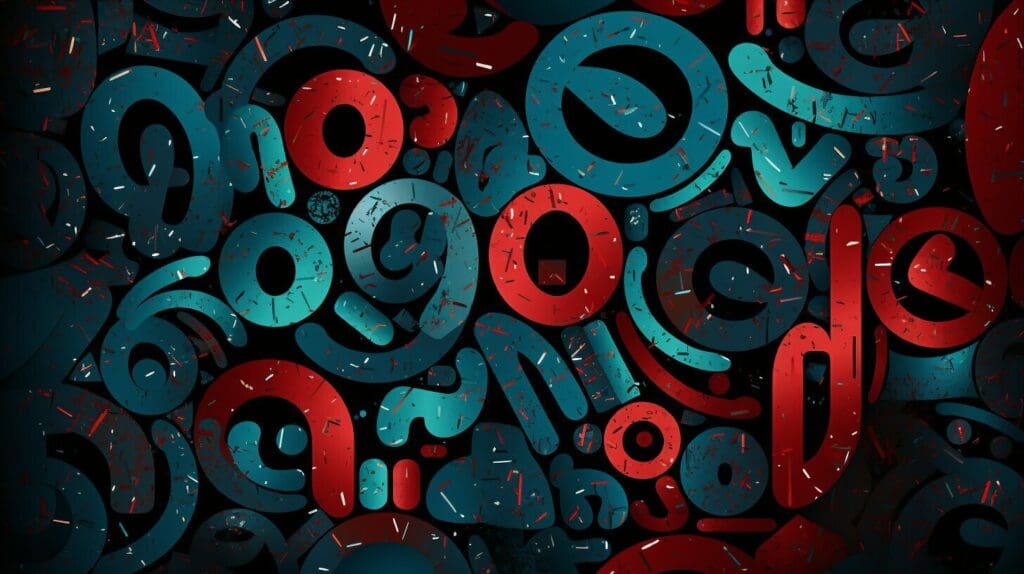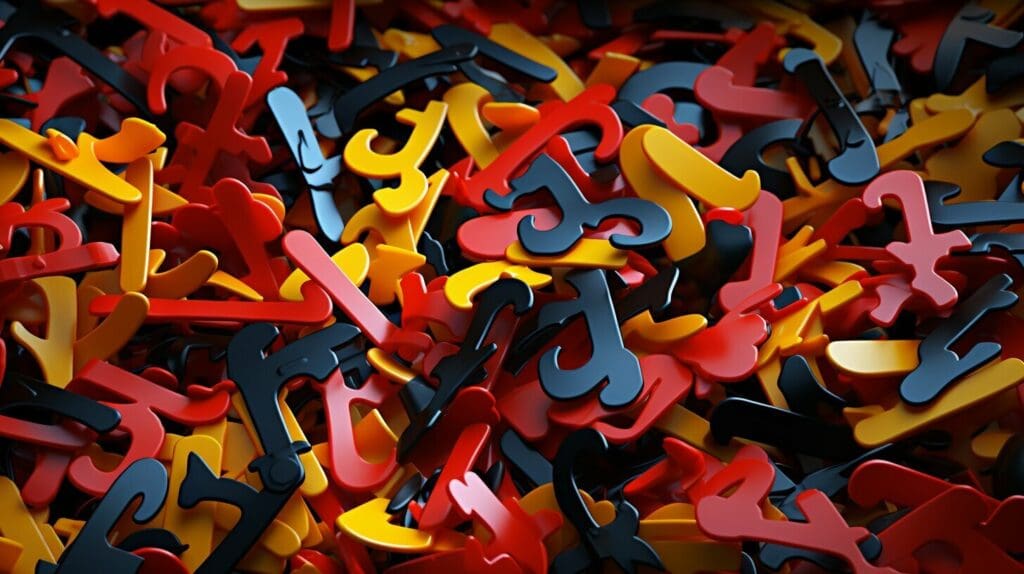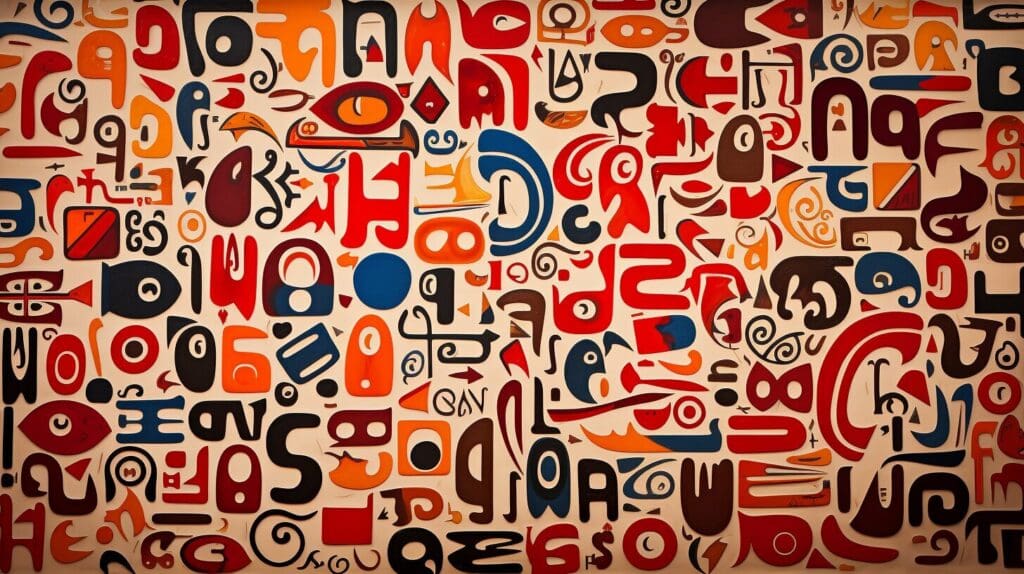When it comes to Spanish punctuation, understanding the rules is crucial. Punctuation marks in Spanish have their own unique characteristics that differ from English. From accent marks to question marks, knowing how to use these punctuation marks correctly is essential for effective communication in written Spanish.
Vamos Academy can help you learn Spanish in Toronto both in-person and online. Start Today
Key Takeaways:
- Spanish punctuation marks have their own rules and differences compared to English.
- Using the correct punctuation is crucial for clear and effective communication in Spanish.
- Spanish punctuation marks include question marks, exclamation marks, commas, periods, quotation marks, and more.
- Understanding Spanish punctuation rules is essential for proper grammar and writing in Spanish.
- Accurate use of punctuation symbols in Spanish enhances language skills and ensures clarity in written communication.
Period (.)
The period is one of the most commonly used punctuation marks in Spanish. Its main function is to indicate the end of a sentence, paragraph, or text. In Spanish, the period is always placed at the end of the sentence, followed by a space before the next sentence begins. It is also used with abbreviations and to express time.
When using the period with abbreviations, it is important to note that it should always be placed after the abbreviated word, without any space between them. For example, “Dr.” for “Doctor” or “Sra.” for “Señora”.
When expressing time, the period is used to separate the hours from the minutes and seconds. For example, “7:45 a.m.” or “9.30 p.m.”.

Usage of the Period
The period is never used to separate or group digits in a number in Spanish. Instead, the comma is used for this purpose. For example, the number “1,000” in English is written as “1.000” in Spanish.
It is important to remember these rules when using the period in Spanish to ensure correct punctuation and enhance comprehension.
| Example | Correct Usage |
|---|---|
| Dr. | Abbreviation for “Doctor” |
| 7:45 a.m. | Indication of time |
| 1.000 | Separation of digits in a number |
Comma (,)
The comma is an essential punctuation mark in Spanish. It is used to separate elements within the same sentence, providing clarity and organization. Here are some common use cases for the comma:
- Separating Items in a List: When listing items in Spanish, a comma is used to separate each item. For example:
| Incorrect | Correct |
|---|---|
| Tengo un perro gato y un pájaro. | Tengo un perro, un gato y un pájaro. |
- Writing Numbers with Decimals: In Spanish, decimals are indicated using a comma instead of a period. For example:
| Incorrect | Correct |
|---|---|
| El resultado es 3.5. | El resultado es 3,5. |
- Addressing Someone: When addressing someone directly in Spanish, a comma is used to separate their name or title from the rest of the sentence. For example:
| Incorrect | Correct |
|---|---|
| María está bienvenido. | María, ¿estás bien? |
It’s important to note that a comma should not be used between the subject and the verb in a sentence. This is a common mistake made by Spanish learners.
By using commas correctly, you can enhance the clarity and effectiveness of your Spanish writing while adhering to the rules of Spanish grammar punctuation.
Ellipsis (…)
Another important punctuation mark in Spanish is the ellipsis. The ellipsis is used to indicate an incomplete list or to convey doubt or suspense. It consists of three dots (…), which are followed by a space. However, if the following word is the beginning of a new sentence, it should be capitalized.
The ellipsis can be used to create anticipation or leave a thought unfinished, adding a sense of mystery to your writing. It is a versatile punctuation mark that can be employed in various contexts, such as literature, poetry, and even casual conversations.
Here is an example of how the ellipsis can be used:
| List of Fruits |
|---|
| Apple |
| Orange |
| Banana |
| Mango |
| … |
In the example above, the ellipsis indicates that there are more fruits in the list, but they are not mentioned. This creates suspense and encourages the reader to imagine what other fruits could be included.

Key Points:
- The ellipsis is used to indicate an incomplete list or to create suspense.
- It consists of three dots (…) followed by a space.
- If the following word is the beginning of a new sentence, it should be capitalized.
Colon (:)
The colon is a punctuation mark used in Spanish to introduce a list, indicate time, and in the header of letters and emails. It is an important punctuation mark that helps provide clarity and structure to written Spanish. When using the colon, it is important to place it next to the previous word and separate it from the following word by a space.
Introducing a List
One of the main uses of the colon in Spanish is to introduce a list. It is commonly used before presenting a series of items, examples, or explanations. The colon helps signal to the reader that a list is about to follow. For example:
Me gustan muchos deportes: fútbol, baloncesto, tenis y natación. (I like many sports: soccer, basketball, tennis, and swimming.)
Indicating Time
The colon is also used to indicate time in Spanish. It is commonly used to separate hours from minutes when expressing time. For example:
Son las 9:30 de la mañana. (It’s 9:30 in the morning.)
Headers of Letters and Emails
In formal letters and emails, the colon is used to separate the greeting or salutation from the body of the message. It helps create a clear distinction between the introductory part and the main content of the communication. For example:
Estimado Sr. López: (Dear Mr. López:)
Overall, the colon is a versatile punctuation mark in Spanish that helps with organizing information, indicating time, and maintaining proper formal structure in written communication.

Table: Examples of Colon Usage
| Usage | Example |
|---|---|
| Introducing a List | Tengo que comprar varios ingredientes: harina, azúcar, huevos y leche. (I need to buy several ingredients: flour, sugar, eggs, and milk.) |
| Indicating Time | Salimos a las 8:00 de la mañana. (We’re leaving at 8:00 in the morning.) |
| Headers of Letters and Emails | Querido amigo: (Dear friend:) |
Question Marks (¿?)
Question marks play a vital role in Spanish punctuation, indicating the beginning and end of a question. Unlike English, Spanish uses both an opening sign (¿) and a closing sign (?) to enclose a question. This unique feature helps readers identify a sentence as a question right from the start. By using question marks correctly, you can effectively communicate in written Spanish and engage with others.
In Spanish, the opening question mark (¿) must always be used at the beginning of a question. It is followed by the question itself and then the closing question mark (?) to signal the end of the question. This punctuation style helps the reader anticipate the question and grasp the meaning of the sentence more easily.
When using question marks in Spanish, remember to place them at the beginning and end of the entire question. This is different from English, where the question mark is placed only at the end of the sentence. By adhering to the proper use of question marks in Spanish, your writing will be more accurate and natural, making it easier for native speakers to understand your intentions.

Table: Examples of Question Marks in Spanish
| Incorrect Usage | Correct Usage |
|---|---|
| ¿Cómo te llamas? | ¿Cómo te llamas? |
| ¿Dónde está la biblioteca | ¿Dónde está la biblioteca? |
| ¿Cuántos años tienes | ¿Cuántos años tienes? |
By using question marks appropriately and consistently in Spanish, you can convey your inquiries clearly and effectively. Whether you’re asking for directions, engaging in a conversation, or simply expressing curiosity, understanding and mastering Spanish question marks is crucial for effective written communication.
Exclamation Marks (¡!)
In Spanish grammar punctuation, exclamation marks are used to express exclamations or strong emotions. They are similar to question marks, but instead of indicating a question, they convey surprise, excitement, or emphasis. In Spanish, the exclamation mark is represented by two symbols: an opening sign (¡) and a closing sign (!).
When using exclamation marks in Spanish, it’s important to remember that the opening sign (¡) must always be placed at the beginning of the exclamation, followed by the closing sign (!) at the end. This unique structure distinguishes exclamations in Spanish from other languages.
Exclamation marks can be used at the beginning or end of a sentence or phrase to express heightened emotions. They can also be used to add emphasis to a particular word or phrase. For example, “¡Qué sorpresa!” (What a surprise!) or “¡Felicidades!” (Congratulations!).

Quotation Marks in Spanish
Quotation marks play an important role in Spanish punctuation. Traditionally, Spanish uses angle brackets («») as quotation marks, but it’s also acceptable to use English quotation marks (“”). Quotation marks are used to enclose words from other languages, quotations, and titles of books, movies, and other artistic works.
In Spanish, quotation marks are placed at the beginning and end of a quoted text, with no spaces between the marks and the enclosed words. For example, «Buenos días» (Good morning) or “Hola” (Hello).
When using quotation marks to enclose a title or a longer quote, they are placed at the beginning and end of the text, with a space between the marks and the enclosed words. For example, «El ingenioso hidalgo Don Quijote de la Mancha» (The Ingenious Gentleman Don Quixote of La Mancha) or “Me encanta este lugar”, dijo Ana (“I love this place,” said Ana).
Examples of Quotation Marks in Spanish:
| Use | Example |
|---|---|
| Quoting someone | «No puedo creerlo» (I can’t believe it) |
| Enclosing book titles | «Cien años de soledad» (One Hundred Years of Solitude) |
| Quoting a phrase | “Vamos a la playa” (Let’s go to the beach) |
Understanding the correct use of quotation marks in Spanish is essential for clear and accurate writing. Whether you choose to use angle brackets or English quotation marks, be consistent throughout your text. Remember to always enclose quoted words or titles to ensure proper punctuation in Spanish.
Slash (/)
The slash (/) is an important punctuation mark in Spanish that serves multiple purposes. It is commonly used in abbreviations to indicate the combination of words or the contraction of a single word. For example, the abbreviation “c/Río” stands for “calle Río” (street Río), and “Dr./Dra.” represents “Doctor/Doctora” (Doctor/Medical Doctor). The slash is also used to show alternative options or choices, such as “mañana/tarde” (morning/afternoon) or “izquierda/derecha” (left/right).
In addition to its use in abbreviations and alternatives, the slash is used to separate the day, month, and year in dates in Spanish. The recommended date format in Spanish is “day/month/year,” where the slash serves as the separator. For example, “10/05/2022” represents October 5, 2022. It’s important to note that Spanish-speaking countries may have different date formats, so it’s always beneficial to familiarize yourself with the specific conventions of the region you are in or communicating with.
Overall, the slash is a versatile punctuation mark in Spanish that aids in abbreviations, indicating alternatives, and separating dates. Its usage is essential for proper communication and understanding in written Spanish.
Examples of Slash Usage
Below are a few examples showcasing the different applications of the slash in Spanish punctuation:
| Usage | Example |
|---|---|
| Abbreviation | c/Río -> calle Río (street Río) |
| Alternative Options | mañana/tarde -> morning/afternoon |
| Date Separation | 10/05/2022 -> October 5, 2022 |
These examples illustrate the diverse roles the slash plays in Spanish punctuation, emphasizing its importance in conveying concise and accurate information.
Other Spanish Punctuation Marks and Symbols
In addition to the commonly used punctuation marks in Spanish, such as the period, comma, and question mark, there are several other punctuation marks and symbols that are worth knowing. These punctuation marks may be used less frequently, but they still play an important role in Spanish writing.
Bullet Point
One such punctuation mark is the bullet point, known as “viñeta” in Spanish. Bullet points are often used to list items or present information in a concise and organized manner. They help to break down complex information into easy-to-read sections, making it easier for readers to understand and navigate the content.
Underscore
The underscore, known as “guion bajo” in Spanish, is another symbol that is occasionally used in Spanish writing. It is often used to connect words or indicate spaces in email addresses, URLs, or file names. The underscore can help to clarify the structure of the text and distinguish between different elements within a sentence or phrase.
Other Symbols
There are also various other symbols that may be used in Spanish writing for different purposes. These symbols include the ampersand (&), the at sign (@), the number sign (#), and the dollar sign ($), among others. These symbols can add visual interest to the text and convey specific meanings or functions depending on the context in which they are used.
Overall, while the period, comma, and question mark are the most commonly used punctuation marks in Spanish, it’s important to be aware of and understand other punctuation marks and symbols that may be encountered in Spanish writing. Familiarizing yourself with these additional punctuation marks will enhance your understanding of the Spanish language and allow you to effectively communicate in written Spanish.

| Punctuation Mark | Symbol | Usage |
|---|---|---|
| Bullet Point | • | Used to list items or present information in a concise manner. |
| Underscore | _ | Used to connect words or indicate spaces in email addresses, URLs, or file names. |
| Ampersand | & | Used to represent the word “and” in certain contexts. |
| At Sign | @ | Used in email addresses and social media handles. |
| Number Sign | # | Used for hashtags and numbering in certain contexts. |
| Dollar Sign | $ | Used to represent currency or monetary values. |
Conclusion
Understanding Spanish punctuation is crucial for anyone looking to learn and communicate effectively in written Spanish. By familiarizing yourself with the different punctuation marks and their usage, you can enhance your language skills and ensure clear communication in Spanish.
From the period that signifies the end of a sentence or paragraph to the comma used for separating elements within a sentence, each punctuation mark serves a specific purpose in Spanish grammar. Additionally, the ellipsis creates suspense or indicates an incomplete list, while the colon introduces a list or denotes time.
Question marks and exclamation marks play a crucial role in forming questions and expressing exclamations in Spanish. The use of quotation marks, either Spanish angle brackets («») or English quotation marks (“”), helps to identify quotes and titles. And the slash is used for abbreviations, indicating possibilities, and formatting dates.
By mastering these Spanish punctuation marks and symbols, you can navigate the intricacies of Spanish grammar and enhance your writing skills. So, whether you are a language learner or someone looking to improve their Spanish proficiency, this comprehensive guide to Spanish punctuation will provide you with the knowledge you need to succeed.
FAQ
What are the most important Spanish punctuation marks?
The most important Spanish punctuation marks are the period (.), comma (,), ellipsis (…), colon (:), question marks (¿?), exclamation marks (¡!), quotation marks («»), slash (/), bullet point (viñeta), and underscore (guion bajo).
How is the period used in Spanish?
The period is mainly used to indicate the end of a sentence, paragraph, or text. It is also used with abbreviations and to express time. However, it is never used to separate or group digits in a number in Spanish.
What is the purpose of a comma in Spanish?
The comma is used to separate elements within the same sentence. It is used to separate items in a list, write numbers with decimals, and indicate when you’re addressing someone. It is important not to use a comma between the subject and the verb in a sentence.
How is the ellipsis used in Spanish?
The ellipsis is used at the end of an incomplete list or to show doubt or suspense. It contains only three dots and is followed by a space. The following word is only capitalized if it’s part of a new sentence.
When should I use a colon in Spanish?
The colon is used to introduce a list, indicate time, and in the header of letters and emails. It is written next to the previous word and separated from the following word by a space.
How are question marks used in Spanish?
Question marks are used to indicate the beginning and end of a question. The opening sign (¿) and closing sign (?) must be used together to write a question in Spanish.
What is the purpose of exclamation marks in Spanish?
Exclamation marks are used for exclamations in Spanish. The opening sign (¡) and closing sign (!) must be used together to write an exclamation in Spanish.
What are the different types of quotation marks used in Spanish?
Spanish traditionally uses angle brackets («») as quotation marks. However, it is also valid to use English quotation marks (“”). They are used with words from other languages, quotations, and titles of books, movies, and other artistic works.
How is the slash used in Spanish?
The slash is used in abbreviations and to show several possibilities. It is also used to separate the day, month, and year in dates. The recommended date format in Spanish is “day/month/year.”
What are some other punctuation marks and symbols in Spanish?
Other less frequently used punctuation marks and symbols in Spanish include the bullet point (viñeta), underscore (guion bajo), and more.

